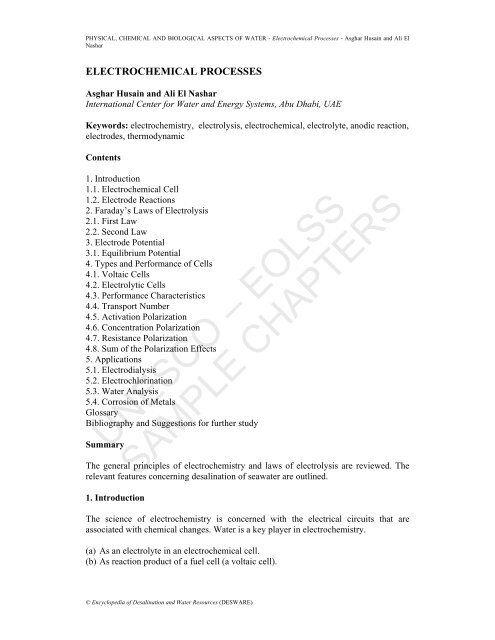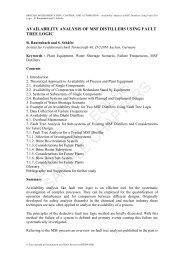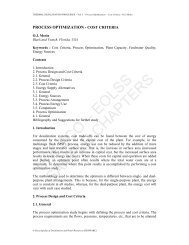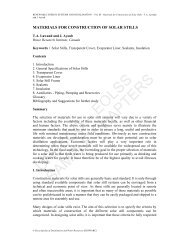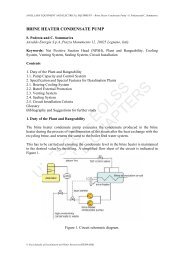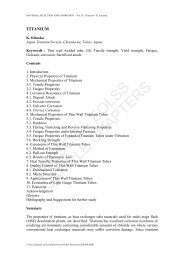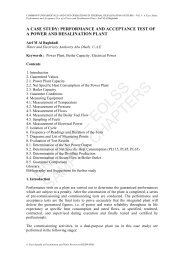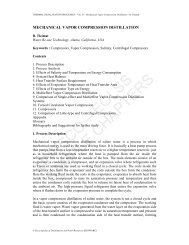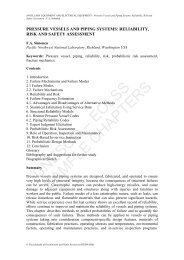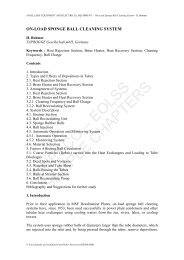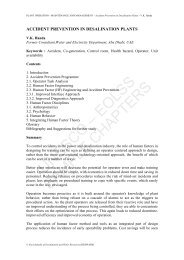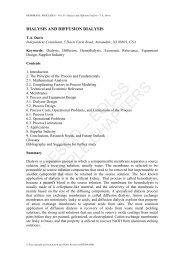Electrochemical Processes - Encyclopedia of Desalination and ...
Electrochemical Processes - Encyclopedia of Desalination and ...
Electrochemical Processes - Encyclopedia of Desalination and ...
Create successful ePaper yourself
Turn your PDF publications into a flip-book with our unique Google optimized e-Paper software.
PHYSICAL, CHEMICAL AND BIOLOGICAL ASPECTS OF WATER - <strong>Electrochemical</strong> <strong>Processes</strong> - Asghar Husain <strong>and</strong> Ali ElNasharELECTROCHEMICAL PROCESSESAsghar Husain <strong>and</strong> Ali El NasharInternational Center for Water <strong>and</strong> Energy Systems, Abu Dhabi, UAEKeywords: electrochemistry, electrolysis, electrochemical, electrolyte, anodic reaction,electrodes, thermodynamicContents1. Introduction1.1. <strong>Electrochemical</strong> Cell1.2. Electrode Reactions2. Faraday’s Laws <strong>of</strong> Electrolysis2.1. First Law2.2. Second Law3. Electrode Potential3.1. Equilibrium Potential4. Types <strong>and</strong> Performance <strong>of</strong> Cells4.1. Voltaic Cells4.2. Electrolytic Cells4.3. Performance Characteristics4.4. Transport Number4.5. Activation Polarization4.6. Concentration Polarization4.7. Resistance Polarization4.8. Sum <strong>of</strong> the Polarization Effects5. Applications5.1. Electrodialysis5.2. Electrochlorination5.3. Water Analysis5.4. Corrosion <strong>of</strong> MetalsGlossaryBibliography <strong>and</strong> Suggestions for further studySummaryUNESCO – EOLSSSAMPLE CHAPTERSThe general principles <strong>of</strong> electrochemistry <strong>and</strong> laws <strong>of</strong> electrolysis are reviewed. Therelevant features concerning desalination <strong>of</strong> seawater are outlined.1. IntroductionThe science <strong>of</strong> electrochemistry is concerned with the electrical circuits that areassociated with chemical changes. Water is a key player in electrochemistry.(a) As an electrolyte in an electrochemical cell.(b) As reaction product <strong>of</strong> a fuel cell (a voltaic cell).© <strong>Encyclopedia</strong> <strong>of</strong> <strong>Desalination</strong> <strong>and</strong> Water Resources (DESWARE)
PHYSICAL, CHEMICAL AND BIOLOGICAL ASPECTS OF WATER - <strong>Electrochemical</strong> <strong>Processes</strong> - Asghar Husain <strong>and</strong> Ali ElNashar(c) As fuel source in hydrogen - producing separation cell (a driven cell).In the context <strong>of</strong> desalination, the relevance <strong>of</strong> electrochemistry is apparent from thefollowing.(a) A major operational problem in desalting processes is the corrosion <strong>of</strong> metalliccomponents, which essentially takes place by electrochemical mechanisms.(b) Electrodialysis, which is basically an electrochemical process, is an importanttechnique for desalting brackish waters.(c) Many <strong>of</strong> the analytical techniques used for characterizing feed <strong>and</strong> product watersare electrochemical in nature.(d) An electrochemical method is utilized to generate the chlorine gas needed tochlorinate water.(e) Some <strong>of</strong> the complex metabolic processes occurring in biological organisms <strong>and</strong>contributing to bi<strong>of</strong>ouling are electrochemical.1.1. <strong>Electrochemical</strong> CellAs shown in Figure 1, a typical electrochemical cell has two different metals, A <strong>and</strong> C,immersed in aqueous solution <strong>and</strong> joined externally by a wire. The aqueous solutioncontains the ions <strong>of</strong> the two metals A + <strong>and</strong> C + , in addition to the ions X - , H + , <strong>and</strong> OH - .The flow <strong>of</strong> electrical current through such a system takes place by the followingmechanisms.(a) Through the connecting wire by normal “free electron” conduction.(b) Through the aqueous solution by movement <strong>of</strong> charged ions.UNESCO – EOLSSSAMPLE CHAPTERSFigure 1. <strong>Electrochemical</strong> cell with two different metals, A <strong>and</strong> C.© <strong>Encyclopedia</strong> <strong>of</strong> <strong>Desalination</strong> <strong>and</strong> Water Resources (DESWARE)
PHYSICAL, CHEMICAL AND BIOLOGICAL ASPECTS OF WATER - <strong>Electrochemical</strong> <strong>Processes</strong> - Asghar Husain <strong>and</strong> Ali ElNasharIn the above arrangement, the charge-transfer process involves chemical reactions at theinterfaces between the metals <strong>and</strong> the solution, which occur either spontaneously or dueto a supply <strong>of</strong> electrical energy from an external source. The two interfaces are knownas electrodes <strong>and</strong> the transfer <strong>of</strong> charged particles across an electrode is associated witha potential difference. In the external circuit, the current flows from the electrode knownas anode towards the electrode called cathode.Finally, an electrochemical cell need not necessarily contain an aqueous solution; anymedium such as molten salt, which can conduct electricity, would serve the purpose.1.2. Electrode ReactionsThe electrodes are usually made up <strong>of</strong> metals <strong>and</strong> the electrode reactions occurring ontheir surface involve either the electrode metal itself or the metallic ions dissolved in theaqueous medium. For example, if one <strong>of</strong> the electrodes comprises a piece <strong>of</strong> iron, thefollowing electrode reaction could take place:Fe → Fe2++ 2e−where “e” represents an electron. This type <strong>of</strong> reaction constitutes a charge-transferprocess releasing electrons; therefore, it is known as an anodic reaction.On the other h<strong>and</strong>, if copper ions are present in the solution (termed as electrolyte), thenthe following electrode reaction takes place with the deposition <strong>of</strong> copper on theelectrode surface (which may or may not be a piece <strong>of</strong> copper):Cu2++ 2e− → CuThis type <strong>of</strong> reaction, which consumes electrons, is called a cathodic reaction.The electrode reactions in electrochemical cells <strong>of</strong>ten involve non-metallic species suchas the following hydrogen evolution reaction:2H++ 2e− → H 2UNESCO – EOLSSSAMPLE CHAPTERSOxygen dissolved in water can also take part in the electrode reactions given below:O2(aq) + 2H2O + 4e−→ 4(OH−)O2(aq)++4H+ 4e− → 2H 2 OIn the above reactions, the term “aq” emphasizes that the reacting oxygen is dissolvedin water. These are important aqueous corrosion reactions which arise during oxygendetermination methods using special instruments.© <strong>Encyclopedia</strong> <strong>of</strong> <strong>Desalination</strong> <strong>and</strong> Water Resources (DESWARE)
PHYSICAL, CHEMICAL AND BIOLOGICAL ASPECTS OF WATER - <strong>Electrochemical</strong> <strong>Processes</strong> - Asghar Husain <strong>and</strong> Ali ElNashar2. Faraday’s Laws <strong>of</strong> ElectrolysisIn the electrode reactions, the relationship between the amount <strong>of</strong> electrical chargetransferred <strong>and</strong> the quantity <strong>of</strong> substance discharged is given by laws <strong>of</strong> electrolysis asdescribed by Faraday.2.1. First LawThe amount <strong>of</strong> any substance dissolved or deposited at an electrode is directlyproportional to the quantity <strong>of</strong> electricity flowing in the circuit.2.2. Second LawThe masses <strong>of</strong> different species dissolved or deposited at electrodes by the samequantity <strong>of</strong> electricity are in direct proportion to their equivalent weights.The above laws are quantitatively expressed as follows: the passage <strong>of</strong> one Faraday <strong>of</strong>charge, i.e. 96 500 coulombs, across an interface involves the consumption or liberation<strong>of</strong> 1/n moles <strong>of</strong> substance. Here, n is the number <strong>of</strong> electrons involved in the reaction<strong>and</strong> it is <strong>of</strong>ten but not always equal to the valency <strong>of</strong> the species in the electrodereaction. For instance, in the above reaction <strong>of</strong> dissolution <strong>of</strong> iron as Fe + ions, thepassage <strong>of</strong> 96 500 coulombs would result in the dissolution <strong>of</strong> 1/2mole = 55.85/2 = 27.93 g <strong>of</strong> iron, where 55.82 is the atomic weight <strong>of</strong> iron.Similarly, passage <strong>of</strong> the same charge would result in the deposition <strong>of</strong> 1/2mole = 63.54/2 = 31.77 g <strong>of</strong> copper, where 63.54 is the atomic weight <strong>of</strong> copper.Thus, the above quantities <strong>of</strong> iron dissolved <strong>and</strong> copper deposited are in proportion totheir respective equivalent weights. For an electric current <strong>of</strong> I A, i.e. I coulombs s -1 , thenumber <strong>of</strong> moles <strong>of</strong> a substance dissolved or deposited would be I/nF, where F = 96 500coulombs. If the electrode surface area is a cm 2 , then the current density i = I/a.Therefore, the deposition or dissolution rate would be i/nF moles cm -2 s -1 .3. Electrode PotentialUNESCO – EOLSSSAMPLE CHAPTERSThe potential difference across the interface <strong>of</strong> an electrode is called the electrodepotential. It is an important parameter which can be construed as a measure <strong>of</strong> thethermodynamic tendency for the spontaneity <strong>of</strong> the electrode reactions.---TO ACCESS ALL THE 17 PAGES OF THIS CHAPTER,Visit: http://www.desware.net/DESWARE-SampleAllChapter.aspx© <strong>Encyclopedia</strong> <strong>of</strong> <strong>Desalination</strong> <strong>and</strong> Water Resources (DESWARE)


